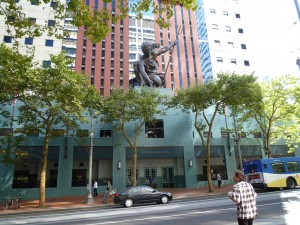
From the ball and chain desk.
The recent demolition of Bertrand Goldberg’s Prentice Hospital, and the announced demolition of Williams & Tsien’s Folk Art Museum, raises the vision—or specter, depending on your point of view—of future demolitions of not-so-old buildings. What happened to the preservation of the past? I have always believed that the undoubted popularity of the historic preservation movement depends less on some abstract notion of heritage conservation and more on the actual architecture being preserved: in the past, that has meant the well-built, well-designed, and much cherished buildings of the late nineteenth and early twentieth century. Now that mid-century modern buildings are coming under the wrecker’s ball, the question becomes more complex. Many of these buildings are not well-built, are cavalierly planned, and are definitely not cherished by the public—some are actively disliked. They are also designed differently. Traditionally, buildings were meant to be durable, not merely physically but aesthetically. That implied a degree of conservatism when it came to design, eschewing the latest fashion, and leaning on past precedents. When architects cut the cord to the past, and focus only on the here-and-now, architecture becomes more exciting and more fashionable, but it also becomes shorter-lived. Rough concrete, googly shapes, oval windows, and built jokes age as badly as hula hoops and pet rocks. No wonder that preservationists have a hard time garnering public support for Brutalist architecture. And postmodernism is next. The Portland City Council is considering whether to demolish the Portland Building, a postmodern landmark by Michael Graves that requires the infusion of $95 million in repairs and improvements. (No one is suggesting destroying Ray Kaskey’s wonderful statue, though.) And one can imagine what will happen in a few years when deconstructivist buildings, many of which are exceedingly poorly built as well as distinctly oddly designed, are put on the block. Spend money fixing them up, or write them off as a bad architectural moment? Expect opposition, outrage—and more demolitions.

Witold: Their respective merits aside, I think the question of whether or not to demolish noteworthy buildings of recent vintage (the Folk Art Museum in NY being the latest flashpoint) is in part also one of context. By this, I mean both physical and historical contexts. Some controversial buildings, reviled by many, may be worthy of preservation merely because of their impact upon the course of architecture. Others may be missed because of (for lack of a better word) the “texture” they impart upon the cities of which they’re a part. The Portland Building was not built well, and far too cheaply to begin with. Nevertheless, I think Portland would be that much poorer if it were torn down. Here’s my take on the fate of Graves’ seminal design: http://sworegonarchitect.blogspot.com/2014/01/the-perils-of-building-cheaply.html#.UtBJWHmA0b0
I liked your blog on the Portland Building. I myself wrote about it in the December 1989 issue of the late lamented Wigwag. I liked the building and said so. But is that a reason to preserve it at great cost? Probably not. That was the point of my blog. Saving beautiful, well-built, exceptionally designed buildings is easy to justify. Saving a building merely because it is architecturally “noteworthy” is not. No period in history has ever felt the obligation to preserve the past in quite the way we seem to.
A tragic irony, that the preservationist instinct that arose in reaction to the wanton destruction of architectural gems now keeps us from demolishing the brutalist monstrosities often built in their place! See City Hall and the West End in Boston.